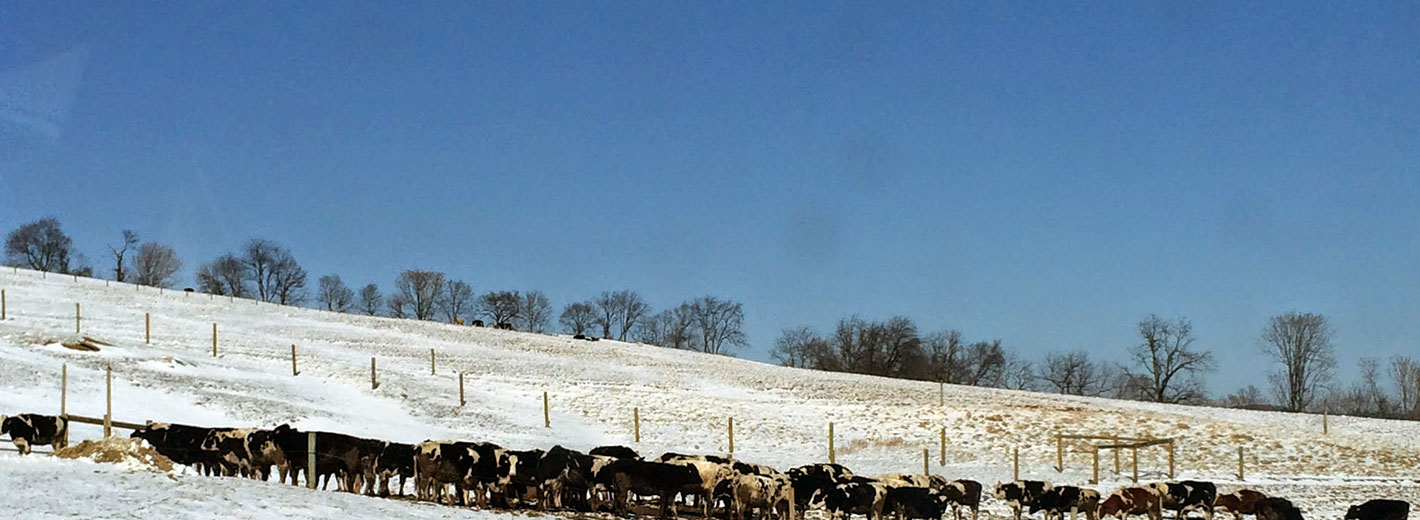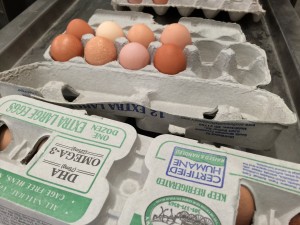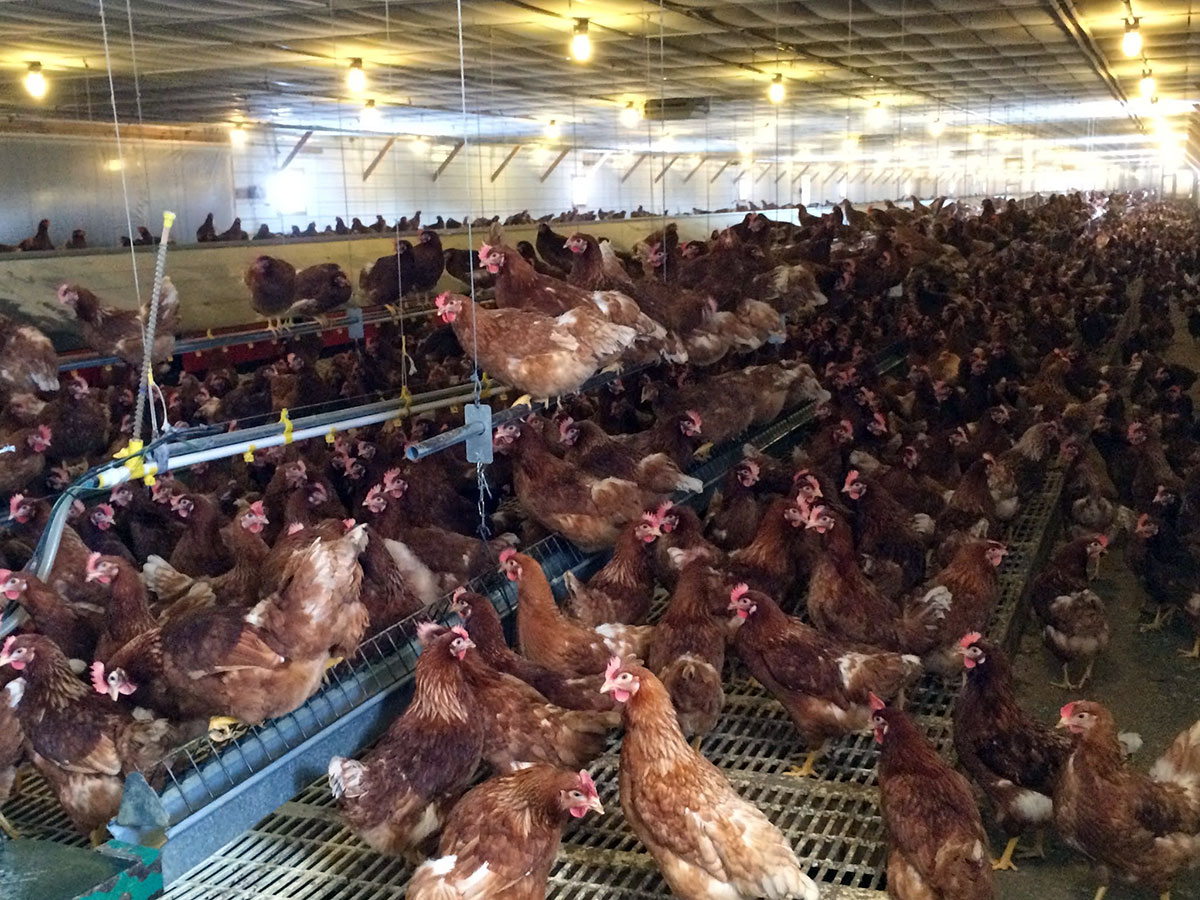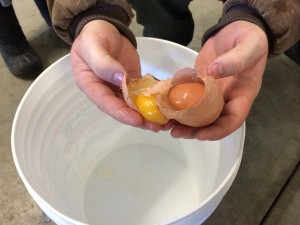
Learning Life Lessons at South Mountain Creamery
- by Sea Sloat
My tour of the hen house at our Farm to Fork partner South Mountain Creamery in Middletown, MD, was full of surprises — not only did I finally get an answer to the age-old chicken-and-egg conundrum, but I also gained a firsthand understanding of why Bon Appétit’s commitment to cage-free shell eggs is a no-brainer.

SMC is proud to carry the Certified Humane label
South Mountain Creamery sells free-range Certified Humane shell eggs to Bon Appétit at Johns Hopkins University, as well as dairy and meat products to 10,000 customers every week. What started as a family dairy in 2001 with Karen and Randy Sowers is now a six-farm operation with 70 employees. Despite the rapid growth, South Mountain has stayed true to its mission of sustainability. They call themselves a “field to fork” operation — dairy cows are born on the farm, raised eating grains grown and processed by South Mountain (as do the laying hens), and milk is processed on-site and sold in their store as ice cream, yogurt, butter, and sour cream. They are also committed to educating consumers about general sustainability issues and food production: they give farm tours, host two festivals a year, and you can watch their calves 24/7 via a live feed on Animal Planet Live.

Being able to perch and roost are possible for cage-free chickens, not battery hens
On a recent visit I got to see where our South Mountain shell eggs come from: a single chicken house with 17,000 hens roaming freely inside. That sounds like a lot of chickens (and it is!) but conventional operations would stuff 100,000 chickens in the same space by using inhumane battery cages (just smaller than an 8.5-by-11-inch sheet of paper) and stacking the cages one on top of the other. According to the Humane Society of the United States, 90 percent of laying hens in the U.S. live in battery cages too small for them to even spread their wings, let alone engage in any other natural behaviors. Trying to imagine five times as many birds in this already-dense space really brought home to me the importance of Bon Appétit’s commitment to sourcing only cage-free shell eggs.
At South Mountain, the hens not only walk about as they please, but also perch, nest, take dust baths, and other natural behaviors. Assurance that birds can experience these behaviors, and enjoy a minimum amount of square footage per bird, are required for a farm to earn a Certified Humane label based on the Humane Farm Animal Care standards for laying hens. South Mountain chickens also have access to the outdoors, which is not required to be Certified Humane, but grants them the ‘free-range’ classification. With the temperature outside at just 8 degrees Fahrenheit, however, none of the chickens I saw were interested in leaving the warmth of the chicken house (kept at a luxurious 70 degrees).

Farmer Larwin Martin shows me how to tell the age of a hen by her comb
Next, farmer Larwin Martin and Marketing and Communications Coordinator Anastasia Gaines guided me through the hen house to the egg processing area. With 16,500 eggs laid a day, packaging has to be mechanized. The eggs travel from the laying boxes by conveyor belt into the processing room, where the first stop is passing through a steam and chlorine sanitation machine. They are then placed over a light box for visual inspection. An egg that is too large for the rest of the machines to process, or has any blemishes or cracks, is removed from the line. The eggs are then weighed and sorted into their appropriate boxes (medium, large, extra large, and jumbo) by machine.
The day of my visit, Martin had come across a particularly large egg during visual inspection. In fact, it was undoubtedly the largest chicken egg I have ever seen. Martin beckoned me over to see what was inside, knowing what the contents would be, and that I would be shocked. Sure enough, Martin cracked open the dinosaur-like egg to reveal a yolk, along with another entire egg, shell and all! Yes, an egg inside an egg. And so when it comes to which came first, the chicken or the egg, the answer, ladies and gentlemen, is….it was never a choice between a chicken and egg, it was always two eggs that came first! (OK, I admit, I am not a scientist, but there must be some kind of existential meaning to glean from this experience — perhaps when we fail to find an answer we simply aren’t asking the right question.)

The surprise of the day: an entire egg in an egg!
After that bit of magic at the hen house, Anastasia brought me to the tranquil calf barn, where about 60 of the cutest little, furry things were trying to stay warm. The barn is open to the public, as are daily calf-feedings and cow milkings. School groups visit throughout the year, and in spring and fall thousands of visitors attend their festivals. Anastasia explained, “A lot of kids that come here have never seen a cow, or been on a farm, so we’re here to share that with them.” South Mountain’s work to connect people to their food deeply resonated with me, especially as I embark on my journey as a Bon Appétit Fellow.
Their commitment to sustainability and education stems from a family history of soil conservationists and school teachers. I was impressed to learn that despite having 70 employees, owners Karen and Randy often still run the 1:30 a.m. milking shift — milking 300 cows between the two of them. My visit to South Mountain Creamery was a good reminder that growing a business doesn’t mean selling out one’s values: a fact Bon Appétit proves every day.